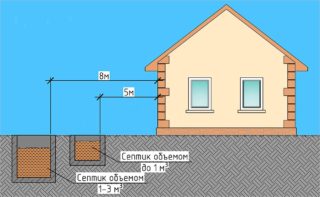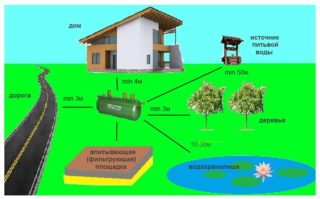Every owner of a private house faced the problem of sewage disposal. The times when people used the outdoor toilet are a thing of the past. They are being replaced by new systems for the disposal of sewage water. One of which you will learn about in this article. Septic tank, part of a local treatment plant. The septic tank is based on the principle of gravitational sedimentation and biological post-treatment, using bioferment preparations, as well as soil natural and forced post-treatment methods. These can be biofilters or bioloading.
There are several types of septic tanks:
- on aerobic bacteria;
- on anaerobic bacteria;
- Using both principles in their work, combined septic tanks ..
The standards and rules governing the installation of septic tanks on the site are:
- The set of rules 32.13330.2012 “Updated edition of SNiP 2.04.03-85“ Sewerage. External networks and facilities ".
- SanPin 2.2.1 / 2.1.1.1200-03.
Accommodation rules
The distance from the septic tank to the source of drinking water, wells or wells is at least 30 meters. If this rule is not observed, then the secondary water that has been treated in a septic tank will get into the drinking water source. Consequence, poisoning, intestinal disorders. The rule applies to the simplest types of septic tanks, concrete rings. In more complex, sealed, plastic septic tanks that use both anaerobic and aerobic bacteria in their work, the removal of clarified water can be carried out with a pump installed in the second chamber of the septic tank through a HDPE hose to any point of the site. The outlet of the water from the hose is 30 meters from the source of drinking water.
The septic tank must be placed at a relief point located below the source of drinking water. If this requirement is not observed during the spring flood, there is a risk of sewage from the septic tank entering the drinking water source.
The distance from the septic tank to the foundation of the house is at least five meters. Over time, the soil around the septic tank, in the case of concrete rings, around the second overflow well, or in the case of a septic tank, with soil purification (drainage field), is saturated with moisture.
The distance from the treatment plant to the public road is at least five meters.
Failure to comply with this norm, there is a risk of getting into road repairs, a cushion of sand and gravel under the asphalt can be washed out by the water coming out of the septic tank.
The neighbor's fence is at least two meters away. Everyone knows how short-lived friendship with neighbors is, which can, over time, turn into fierce enmity. Therefore, it is better to fulfill the standard than to suffer later with the transfer of the treatment plant.
If the septic tank is located in the area of passage of the owner's cars, it must be reinforced from above with concrete reinforcement. We are talking about a plastic septic tank, the passage of cars is not terrible with concrete rings. If you save on concrete, then you will soon have to deal with the repair of plastic, which passenger cars with their weight can deform.
The septic tank is buried at the lowest point of the site.This will save on earthworks, plus, if you do not follow it, and will place it at the top of the site, then the likelihood that the gray cleaned-up waters of the septic tank will get into your house increases.
The depth of the septic tank and the distance from the house
The distance from the house to the septic tank should be at least five meters, but you should not do much more than a given value. The sewer pipe has a slope of the order of two centimeters per meter. The calculation will show that at a distance of five meters from the house, the pipe will go down ten centimeters. The starting point for calculating the slope of the pipe is taken at least 30 centimeters from the ground to the top of the pipe, laid horizontally on a sand cushion, near the foundation, at the place where the pipe passes into the house through the foundation. These data are taken from the experience of many years of installation and operation. So that the pipe does not freeze at such a depth, thermal insulation is put on the pipe. The opinion that the sewer pipe should be buried below the freezing depth is wrong! Laying the sewer pipe to a depth below 1.5 meters leads to the following errors:
- The septic tank, if these are concrete rings, will be filled by 1/3 part if the well consists of two rings.
- If it is a plastic septic tank with soil post-treatment, then at such a depth during a spring flood through the drainage field the treatment station will be filled with flood water and the system will not be able to work.
- With a high level of groundwater in the area, due to the characteristics of the terrain, both systems will also be inoperative.
Install the system no further than five meters from the house, so that the septic tank does not go underground too much, and you will ensure its normal operation even in spring floods. The pipe, in thermal insulation, laid with a slope in accordance with GOST at the starting point of 30 centimeters from the ground surface, does not need to be additionally heated with a heating cable, heat is released in the first chamber of the septic tank during rotting and fermentation, it does not allow the pipe dressed in thermal insulation to freeze. Plus, the wastewater is the same warm. If, for some reason, the treatment plant has to be installed more than five meters, then according to SNIP, every fifteen meters of the pipe in a straight section, at each turn and bend of the sewer pipe, an inspection well is installed.
Small plot problems
What to do if you got a small area where it is problematic to comply with all norms and GOSTs:
- Buy a combination plant that processes aerobic and anaerobic bacteria. The degree of purification after such an installation can reach 98%, according to the passport. The water can be used for irrigation. The main idea is that the cleaner the water at the outlet of the septic tank, the easier it is to dispose of.
- If the septic tank cannot be installed at a distance of 30 meters from the source of drinking water, be sure to put drinking filters on the water, the ideal option is a reverse osmosis system, the degree of water purification after osmosis allows you to drink it without boiling.
- If it is impossible to place a septic tank further than five meters from the house, there are two options: to make additional waterproofing of the foundation in the area of the treatment plant when the house has already been built. If the house is still in the project, install it on a pile foundation, which has proven itself well in areas with high groundwater levels.











